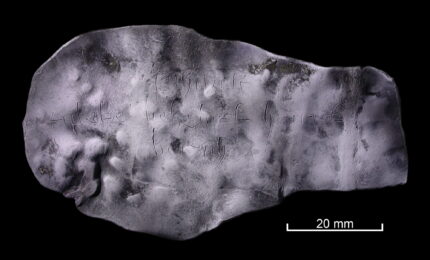A lead curse tablet invoking Satan and two other devils has been discovered in a 15th century latrine in Rostock on the north coast of Germany. This is the first curse tablet from the Middle Ages found in Germany.
Curses, known as defixiones in Latin, inscribed on lead were widespread in ancient Greece and Rome well into the Christian era. They invoked demonic or divine powers to destroy rival businesses, rival sports teams, rival in love, opponents in lawsuits, people who had done them a wide variety of wrongs. They were also love/sex spells, intended to compel a target’s love or passion, or compel a wrong to be righted.
The curse was scratched on a small sheet of soft lead, rolled or folded up with the text on the inside and placed in an area considered to be a gateway to the chthonic powers like a grave, a well or a temple, places where the targets could not find them and the gods of the underworld could. There are about 1,500 ancient curse tablets known on the archaeological record, with new ones cropping up regularly, sometimes by the dozens as certain locations were popular curse receptacles for centuries.
The era of the lead curse tablet came to an end in the early 7th century. While curses have been found from later eras, they were in different formats. Apparently the ancient tradition was still in practice in medieval Rostock at least once.
The tablet was discovered during an excavation preliminary to the expansion of Rostock’s town hall. At first it seemed like just a random rolled up piece of metal, but when it was unrolled the inscription “sathanas taleke belzebuk hinrik berith” was found inside. Written in Gothic minuscule script, the inscription is a list of names. Satan, Beelzebub and Berith (aka Baʿal Berith, a Canaanite deity which in the Rabbinic tradition is equated with Beelzebub) are the invoked devils. Taleke and Hinrik are the apparent targets of the curse. Was this perhaps a spurned lover sicking devils on a couple to break them up? That would certainly be in keeping with the ancient approach to curse tablets.
So is the location where the curse was stashed. A latrine is even closer to the underworld than a well, and there was no way the targets of the curse could happen upon it down in the depths of human waste collection.

This is apparently in ‘Low German’.
However, “Taleke” turns out to be the diminutive of the female given name of “Taalke”. Therefore, the invocation of that ‘Unholy Trinity’ seemingly aims at some form of relationship between Hinrik and Taalke.
– I wonder if all of them were using the same latrine 😈️